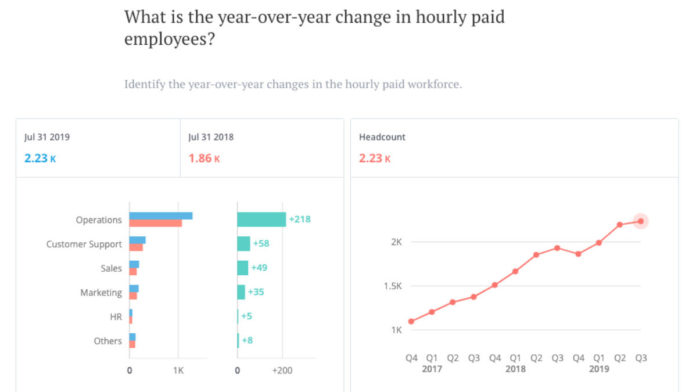
Visier added new features to its Visier People platform to provide enterprise organizations with insights into their hourly, contract and seasonal workers.
The package, called Visier People Workforce, connects workforce data from any available source to generate information business leaders can use to develop and implement more effective workforce strategies.
Noting that some 60 percent of U.S. workers are considered “hourly,” Visier CEO John Schwarz said ready access to data on areas such as flight risk, productivity, absenteeism and training results is “essential” to running a business in today’s economy.
.@Visier People Workforce connects workforce data from any source to generate information to help develop and implement more effective workforce strategies. #HR #HRTech #HRTribe Share on XWorkforce provides employers with some 125 questions relating to workforce behavior and management. Teams can then refine the questions with data filters or use them as a starting point to create their own metrics.
Visier said Workforce can help leaders reduce unnecessary overtime pay, discover the drivers of absenteeism in order to correct them, spot safety risks and build more detailed employee histories.
Continuing Enhancements to Visier People
Visier’s been actively expanding the scope of Visier People since the suite launched in May 2019. Visier People specifically targets chief diversity officers and other executives interested in incorporating analytics into their D&I work. At the time Chief People Officer Paul Rubenstein said the product was meany to close the gap between diversity numbers, goals and action. Visier sees People’s ability to make insights more visible as being critical to D&I efforts. “Visibility is a critical step to leveling the playing field,” Rubenstein said.
Soon after launching the product, Visier announced a data integration with TrustSphere, a company that provides relationship analytics and organizational network analysis. The integration allows users to review ONA metrics and wider workforce data side-by-side. Relationship network data is difficult to gather, even though it can help identify hidden talent and key influencers, the company said.
In July, Visier added “what if” capabilities to People. These were designed to help front-line managers develop plans for future recruiting and retention efforts. At the time Vice President of People Operations Ian Cook said the new tools would help employers make workforce-related decisions with more certainty.
Many D&I specialists are somewhat skeptical about the impact data can have on meeting corporate diversity goals. They argue that a manager who’s biased to begin with is likely to remain biased—and that bias is likely to impact their decision-making—even if they have access to better data.
On the other hand, said Rubenstein, improved D&I “[forces] us to hold a mirror to ourselves and face empirical truths that we may not have held evident before.” That kind of “objective lens,” he said, “forces us to change our behavior for the better or find ourselves being held accountable by others for not changing these behaviors.”
Sign up for our newsletter here.
Image: Visier













